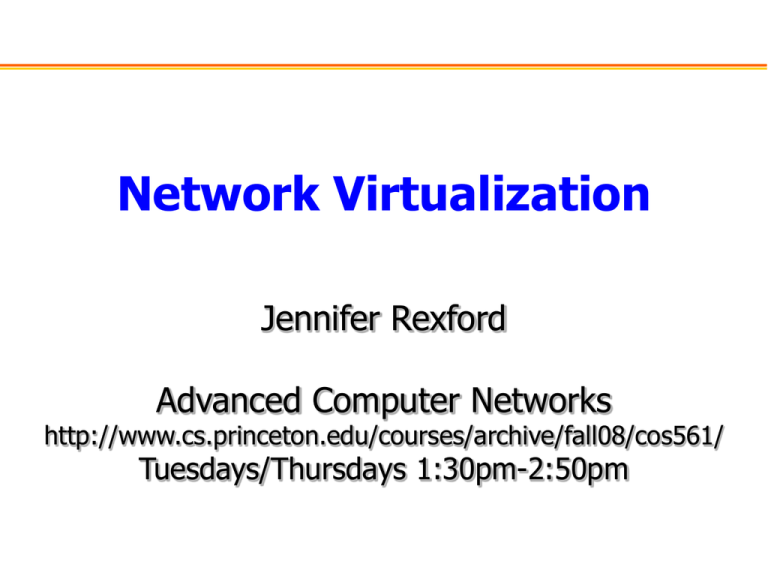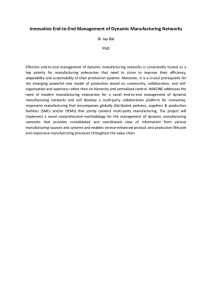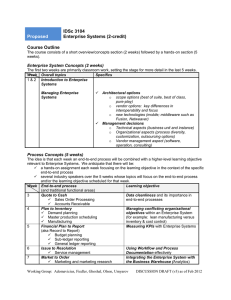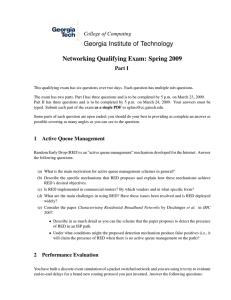Programmability: Network Virtualization
advertisement

Network Virtualization Jennifer Rexford Advanced Computer Networks http://www.cs.princeton.edu/courses/archive/fall08/cos561/ Tuesdays/Thursdays 1:30pm-2:50pm Introduction • Motivation for network virtualization – Deployment dilemma, too many design goals, and coordination constraint • Pluralist networks – Economic refactoring – Infrastructure and service providers • Research challenges – Systems challenges – Resource allocation The Internet: A Remarkable Story • Tremendous success – From research experiment to global communications infrastructure • The brilliance of under-specifying – Best-effort packet delivery service – Key functionality at programmable end hosts • Enabled massive growth and innovation – Ease of adding hosts and link technologies – Ease of adding services (Web, P2P, VoIP, …) • But, change is easy only at the edge… Rethinking the Network Architecture • But, the Internet is showing signs of age – Security, mobility, availability, manageability, … • Challenges rooted in early design decisions – Weak notion of identity, tying address & location – Not just a matter of redesigning a single protocol • Revisit definition and placement of function – What are the types of nodes in the system? – What are their powers and limitations? – What information do they exchange? Hurdle #1: Deployment Dilemma • An unfortunate catch-22 – Must deploy an idea to demonstrate feasibility – Can’t get an undemonstrated idea deployed • A corollary: the testbed dilemma – Production network: real users, but can’t change – Research testbed: easy changes, but no users • Bad for the research community – Good ideas sit on the shelf – Promising ideas do not grow up into good ones Hurdle #2: Too Many Design Goals • Many different system-engineering goals – Scalability, reliability, security, privacy, robustness, performance guarantees, … – Perhaps we cannot satisfy all of them at once • Applications have different priorities – Online banking: security – Web surfing: privacy, high throughput – Voice and gaming: low delay and loss • Compromise solution isn’t good for anyone Hurdle #3: Coordination Constraint • Difficult to deploy end-to-end services – Benefits only when most networks deploy – No single network wants to deploy first • Many deployment failures – QoS, IP multicast, secure routing, IPv6,… – Despite solving real, pressing problems • Increasing commoditization of ISPs 1 sender 2 3 receiver Virtualization to the Rescue • Multiple customized architectures in parallel – Multiple logical routers on a single platform – Isolation of resources, like CPU and bandwidth – Programmability for customizing each “slice” Overcoming the Hurdles • Deployment Dilemma – Run multiple experimental networks in parallel – Some are mature, offering services to users – Isolated from others that are works in progress • Too Many Design Goals – Run multiple operational networks in parallel – Customized to certain applications and users • Coordination Constraint – Run multiple end-to-end services in parallel – Over equipment owned by different parties Pluralist Future The Case for Pluralism • Suppose we can break down the barriers… – Enable realistic evaluation of new ideas – Overcome the coordination constraint • Maybe there isn’t just one right answer – Maybe the problem is over-constrained – Too many goals, some of them conflicting • Maybe the goals change over time – And we’ll always be reinventing ourselves – The only constant is change • So, perhaps we should design for change Different Services, Different Goals • Performance – Low delay/jitter: VoIP and online gaming – High throughput: bulk file transfer • Security/privacy – High security: online banking and e-commerce – High privacy: Web surfing • Scalability – Very scalable: global Internet reachability – Not so scalable: communication in small groups Applications Within an Single ISP • Customized virtual networks – Security for online banking – Fast-convergence for VoIP and gaming – Specialized handling of suspicious traffic • Testing and deploying new protocols – Evaluate on a separate virtual network – Rather than in a dedicated test lab – Large scale and early-adopter traffic • Leasing virtual components to others – ISPs have unused node and link capacity – Can allow others to construct services on top Economic Refactoring in CABO Infrastructure Providers Service Providers • Infrastructure providers: Maintain routers, links, data centers, and other physical infrastructure • Service providers: Offer end-to-end services (e.g., layer 3 VPNs, SLAs, etc.) to users Today: ISPs try to play both roles, and cannot offer end-to-end services Similar Trends in Other Industries • Commercial aviation – Infrastructure providers: Airports – Infrastructure: Gates, “hands and eyes” support – Service providers: Airlines JFK SFO PEK ATL E.g.: airplanes, auto industry, and commercial real estate Communications Networks, Too! • Two commercial examples in IP networks – Packet Fabric: share routers at exchange points – FON: resells users’ wireless Internet connectivity Broker • FON economic refactoring – Infrastructure providers: Buy upstream connectivity – Service provider: FON as the broker (www.fon.com) Enabling End-to-End Services • Secure routing protocols • Multi-provider Virtual Private Networks • Paths with end-to-end performance guarantees Today Competing ISPs with different goals must coordinate Cabo Single service provider controls end-to-end path Research Challenges Virtualized and Programmable Routers • Multiple routers on a single substrate – Multiple control planes – Multiple data planes • Design trade-offs – Speed: aggregate forwarding performance • Getting close to raw forwarding speed – Isolation: avoiding interference • Avoiding jitter and resource contention – Customization: programmability of the data plane • Moving beyond IPv4 packets and Ethernet frames • Software (e.g., Click) vs. hardware (e.g., NetFPGA)? Control Frameworks • Embedding virtual topology in physical one – Finding suitable physical nodes and physical links – With enough CPU, bandwidth, and memory – … and satisfying geographic and delay constraints • Instantiating the virtual network – Creating each virtual node and virtual link – Reserving the necessary resources • Monitoring the running system – Detecting and diagnosing problems – Providing measurement data to virtual network Ways to Exploit Router Virtualization • Exploiting the new capabilities in routers – Separation of the physical from the logical – Ability to run multiple routers in parallel • Example: virtual router migration – Moving router from one physical node to another – E.g., for planned maintenance or service roll-out • Example: bug-tolerant routers – Running multiple instances of routing software – … and “voting” to protect the system from bugs Discussion: Internet vs. Pluralism • Internet architecture – End-to-end argument – Best-effort packet-delivery service – Narrow waist of IP – Separation of intradomain from interdomain • Virtualized programmable networks – Complete control within a virtual network – Programmable functionality inside the network – Different (virtual) networks for different services Discussion: Experimental Infrastructure • How to evaluate research ideas? – Analysis – Simulation – Prototyping – Deployment studies • Importance of wide-area deployment? – Realistic traffic and network conditions – Real users and participation in experiments • How real does real need to get? • Will researchers bother to build and deploy? – Incentives for conducting this kind of research




